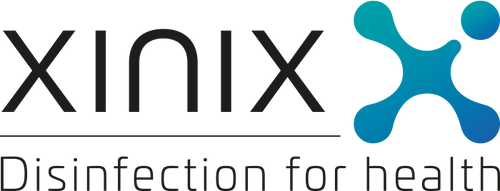Vad är skillnaden mellan Xinix och andra produkter?
Xinix produkter inaktiverar ALLA virus, svamp & bakterier som t.ex E-Coli, Legionella, Salmonella, SARS-COVID och Clostridium.
XINIX FreeBact® Water | Drink & Tank
Stora skillnaden mellan vår produkt och t.ex klorbaserad, är att man med Xinix FreeBact Water endast får i sig knappt spårbar mängd vanligt salt som restprodukt.
Smakar inte simbassäng & du får inte i dig några kemikalier (till skillnad mot t.ex klortabletter).
Klorbaserad desinfektion av vatten och ytor tar tid. Bakterier kan dessutom bygga upp en resistens mot kloret. Det krävs också en betydligt större mängd klor än klordioxiden i Xinix-produkter.
XINIX FreeBact® Surface
Man behöver väldigt lite, ca halva volymen för att desinficera ytorna jämfört med alkoholbaserade produkter och det tar under en minut.
Alkoholbaserad desinfektion har ingen effekt på nakna virus eller sporbildande bakterier som är en stor orsak till sjukvårdsrelaterade infektioner som gör att 4 personer dör varje dag i Sverige. Akoholbaserade desinfektionsprodukter kan även medföra nariga och ansträngda händer, vilket i sin tur kan ge problem med att få på skyddshandskar, samt allmänt obehag.
Xinix-produkter är cirka 5 gånger så effektiva som klorbaserade desinfektionsmedel och 3 gånger så effektiva som alkoholbaserade.
Se diagram nedan för jämförelse med klor, alkohol, väteperoxid, klöverextrakt, ozon, quats och kolloidalt silver.
[Källor sist på sidan]

Xinix FreeBact® Water and Xinix FreeBact® Surface / Chlorine dioxide
✅ Low toxicity [1, 2]
✅ Leaves no harmfull chlorinated, organic by-products
✅ Aqueous solution; smooth on skin
✅ Very high activity against bacteria, fungi, yeasts, viruses [1, 3]
✅ Application on surfaces, water, hands, food [4]
✅ Leaves no smell or taste in water

Alcohol
❌ Flammable liquids (hazardous compounds)
❌ Not useful for drinking water
❌ Low activity against certain viruses (e.g. Poliovirus, Hepatitis A virus, Human enterovirus 71, Parvovirus) [8]
❌ Slow to very slow against certain bacteria spores (e.g.Bacillus) [9]
❌ Not applicable to all surfaces (e.g. rubber)
❌ Not useful for water or food disinfection

Chlorine
❌ Leaves cancerogenic, by-products in water (trihalomethanes) [5]
❌ Can chlorinate surfaces (e.g. food) / so called ‘chlorine chicken’
❌ Decreased effect at higher pH-values (above pH = 3) [6]
❌ Fails against Cryptosporidium sp. (disease causing protozoon) [7]
❌ Dangerous to apply as gas (pressure cylinder)
❌ Leaves strong chlorine smell / taste

Clover extract (Trifolium sp.)
❌ Can be poisonous (red clover poisoning in horses)
❌ Only useful as antibiotic (medical regulation) not as disinfectant
❌ Very high concentrations necessary [15]
❌ Expensive
❌ Not in BPR review program as biocidal active substance
❌ Not active against Shigella and Pseudomonas species (harmful bacteria) [15]

Colloidal silver
❌ Toxic heavy metal
❌ Toxic ingredients within the formulation (e.g. surfactants)
❌ Environmental concern due to nanoparticles
❌ Expensive
❌ Can cause ‘argyria’ – permanent blue stain of skin [21]
❌ Not useful for water or food disinfection

Hydrogen peroxide
❌ Hazardous compound (transport regulation) [12]
❌ Bacteria have specific defence mechanism (enzyme: catalase) [11]
❌ High concentrations necessary (corrosive) [10]
❌ Low effect against C. albicans (infective yeast species) [13]
❌ Not useful for metal surfaces (stains)
❌ Incompatible with some surfaces (e.g. plastics, copper) [14]

Ozone
❌ Highly toxic, fatal if inhaled [16]
❌ Energy consuming [17]
❌ Difficult to apply (instrumentation) [17]
❌ Not compatible with certain materials (e.g. plastics)
❌ Not applicable for human use (e.g. hands)
❌ Low water solubility (1 ppm at 0˚C) [18]

Quats
❌ Chronic environ-mental toxicity with long lasting effects [19]
❌ Suspected to have reproductive toxicity [20]
❌ Can not be applied to drinking water
❌ Expensive
❌ Environmental concern over synthesis by-products
❌ Not useful for water or food disinfection
Sources / Citations
1.J.-W. Ma, B.-S. Huang, C.-W. Hsu, C.-W. Peng, M.-L. Cheng, J.-Y. Kao, T.-D. Way, H.-C. Yin 1, S.-S. Wang, Efficacy and Safety Evaluation of a Chlorine Dioxide Solution, Int. J. Environ. Res. Public Health, 2017, 14, 329.
2.J. R. Lubbers, S. Chauan, J. R. Bianchine, Controlled clinical evaluations of chlorine dioxide, chlorite and chlorate in man, Environ. Health Perspect., 1982, 46, 57–62.
3.S. Yee, Y. C. Lim, C. F. Goh, Vijay Kotra, L. C. Ming, Efficacy of chlorine dioxide as a disinfectant, Prog. Microbes Mol. Biol., 2020; 3(1): a0000128.
4.S. K. Malka, M.-H. Park, Fresh Produce Safety and Quality: Chlorine Dioxide’s Role, Front. Plant Sci., Sec. Crop and Product Physiology, 2022.
5.www.cdc.gov/healthywater/global/household-water-treatment/chlorination-byproducts.html
6.pKs (HClO) = 7.53; www.en.wikipedia.org/wiki/Hypochlorous_acid
7.F. E. Adeyemo, G. Singh, P. Reddy, F. Bux, T. A. Stenström, Efficiency of chlorine and UV in the inactivation of Cryptosporidium and Giardia in wastewater, PLoS One, 2019; 14(5): e0216040.
8.G. Kampf, Efficacy of ethanol against viruses in hand disinfection, J. Hosp. Infect., 2018, 98, 331-338.
9.P. Thomas, Long-term survival of Bacillus spores in alcohol and identification of 90% ethanol as relatively more spori/bactericidal, Curr. Microbiol., 2012, 64, 130-9.
10.L.E. Murdoch, L. Bailey, E. Banham, F. Watson, N.M.T. Adams, J. Chewins, Evaluating different concentrations of hydrogen peroxide in an automated room disinfection system, Letters in Applied Microbiology, 2016, 63, 178—182.
11.M. Baureder, R. Reimann, L. Hederstedt, Contribution of catalase to hydrogen peroxide resistance in Enterococcus faecalis, FEMS Microbiology Letters, 2012, 331, 160–164.
12.www.echa.europa.eu/information-on-chemicals/cl-inventory-database/-/discli/details/53297
13.B. M. Peters, R. M. Ward, H. S. Rane, S. A. Lee, M. C. Noverr, Efficacy of Ethanol against Candida albicans and Staphylococcus aureus Polymicrobial Biofilms, Antimicrob. Agents Chemother., 2013, 57, 74–82.
14.www.ozoneservices.com/articles/004.htm
15.A. V. Khan, Q. U. Ahmed, I. Shukla, A. A. Khan, Antibacterial activity of leaves extracts of Trifolium alexandrinum Linn. against pathogenic bacteria causing tropical diseases, Asian Pac. J. Trop. Biomed., 2012, 2, 189–194.
16.www.echa.europa.eu/information-on-chemicals/cl-inventory-database/-/discli/details/132693
18.www.en.wikipedia.org/wiki/Ozone
19.www.echa.europa.eu/information-on-chemicals/cl-inventory-database/-/discli/details/99975
20.T. C. Hrubec, V. E. Melin, C. S. Shea, E. E. Ferguson, C. Garofola, C. M. Repine, T. W. Chapman, H. R. Patel, R. M. Razvi, J. E. Sugrue, H. Potineni, G. Magnin-Bissel, P. A. Hunt, Ambient and Dosed Exposure to Quaternary Ammonium Disinfectants Causes Neural Tube Defects in Rodents, Birth Defects Research, 109, 2017, 1166–1178.
21.J. J. Kim, L. McCulley, K. Konkel, I.-L. Diak, Cases of Argyria Associated With Colloidal Silver Use, Annals of Pharmacology, 2019, 53, 867-870.


